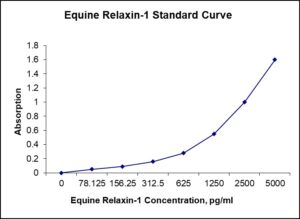Nori Equine Relaxin-1 ELISA Kit
$461.00 – $832.00
This ELISA kit is for quantification of relaxin-1 in horse. This is a quick ELISA assay that reduces time to 50% compared to the conventional method, and the entire assay only takes 3 hours. This assay employs the quantitative sandwich enzyme immunoassay technique and uses biotin-streptavidin chemistry to improve the performance of the assays. An antibody specific for RLN1 has been pre-coated onto a microplate. Standards and samples are pipetted into the wells and any RLN1 present is bound by the immobilized antibody. After washing away any unbound substances, a detection antibody specific for RLN1 is added to the wells. Following wash to remove any unbound antibody reagent, a detection reagent is added. After intensive wash a substrate solution is added to the wells and color develops in proportion to the amount of RLN1 bound in the initial step. The color development is stopped, and the intensity of the color is measured.
Alternative names for relaxin-1: RLN1
This product is for laboratory research use only not for diagnostic and therapeutic purposes or any other purposes.
- Description
- How Elisa Works
- Product Citation (0)
- Reviews (0)
Description
Nori Equine Relaxin-1 ELISA Kit Summary
Alternative names for relaxin-1: RLN1
Alternative name for equine: Horse
| Assay Type | Solid Phase Sandwich ELISA |
| Format | 96-well Microplate or 96-Well Strip Microplate |
| Method of Detection | Colorimetric |
| Number of Targets Detected | 1 |
| Target Antigen Accession Number | P22969 |
| Assay Length | 3 hours |
| Quantitative/Semiquantitative | Quantitative |
| Sample Type | Plasma, Serum, Cell Culture, Urine, Cell/Tissue Lysates, Synovial Fluid, BAL, |
| Recommended Sample Dilution (Plasma/Serum) | No dilution for sample <ULOQ; sufficient dilution for samples >ULOQ |
| Sensitivity | 15 ng/mL |
| Detection Range | 78.13-5000 ng/mL |
| Specificity | Equine relaxin-1 |
| Cross-Reactivity | < 0.5% cross-reactivity observed with available related molecules, < 50% cross-species reactivity observed with species tested. |
| Interference | No significant interference observed with available related molecules |
| Storage/Stability | 4 ºC for up to 6 months |
| Usage | For Laboratory Research Use Only. Not for diagnostic or therapeutic use. |
| Additional Notes | The kit allows for use in multiple experiments. |
Standard Curve
Kit Components
1. Pre-coated 96-well Microplate
2. Biotinylated Detection Antibody
3. Streptavidin-HRP Conjugate
4. Lyophilized Standards
5. TMB One-Step Substrate
6. Stop Solution
7. 20 x PBS
8. Assay Buffer
Other Materials Required but not Provided:
1. Microplate Reader capable of measuring absorption at 450 nm
2. Log-log graph paper or computer and software for ELISA data analysis
3. Precision pipettes (1-1000 µl)
4. Multi-channel pipettes (300 µl)
5. Distilled or deionized water
Protocol Outline
1. Prepare all reagents, samples and standards as instructed in the datasheet.
2. Add 100 µl of Standard or samples to each well and incubate 1 h at RT.
3. Add 100 µl of Working Detection Antibody to each well and incubate 1 h at RT.
4. Add 100 µl of Working Streptavidin-HRP to each well and incubate 20 min at RT.
5. Add 100 µl of Substrate to each well and incubate 5-30 min at RT.
6. Add 50 µl of Stop Solution to each well and read at 450 nm immediately.
Background:
Relaxin is a protein hormone first described in 1926 by Frederick Hisaw.[1] The relaxin family belongs to insulin superfamily and consists of 7 peptides of high structural but low sequence similarity; relaxin-1 (RLN1), 2 (RLN2) and 3 (RLN3), and the insulin-like (INSL) peptides, INSL3, INSL4, INSL5 and INSL6. The functions of relaxin-3, INSL4, INSL5, INSL6 remain uncharacterised.[2] Relaxins are known endocrine and autocrine/paracrine hormones. relaxin is a heterodimer of two peptide chains of 24 and 29 amino acids linked by disulfide bridges, and it appears related to insulin. The protein is synthesized as a single-chain polypeptide but the active form consists of an A chain and a B chain linked by disulfide bonds. Relaxin is produced by the ovary, and targets the mammalian reproductive system to ripen the cervix, elongate the pubic symphysis and inhibit uterine contraction. It may have additional roles in enhancing sperm motility, regulating blood pressure, controlling heart rate and releasing oxytocin and vasopressin. In the female, it is produced by the corpus luteum of the ovary, the breast and, during pregnancy, also by the placenta, chorion, and decidua. In the male, it is produced in the prostate and is present in human semen.[3] Relaxin interacts with the relaxin receptor LGR7 (RXFP1) and LGR8 (RXFP2), which belong to the G protein-coupled receptor superfamily.[4] They contain a heptahelical transmembrane domain and a large glycosylated ectodomain, distantly related to the receptors for the glycoproteo hormones, such as the LH-receptor or FSH-receptor. Endogenous relaxin regulates collagen deposition in an animal model of allergic airway disease.[5]
References
- Becker GJ, Hewitson TD (2001). Kidney Int. 59 (3): 1184–5.
- Wilkinson TN, et al. (2005) BMC Evolutionary Biology. 5: 14.
- MacLennan AH (1991). Scandinavian journal of rheumatology. Supplement. 88: 7–15.
- Arroyo JI, et al. (2014) Genome Biology and Evolution. 6 (3): 491–9.
- Mookerjee I, et al. (2006). Endocrinology. 147 (2): 754–61.
Be the first to review “Nori Equine Relaxin-1 ELISA Kit”
You must be logged in to post a review.





























Reviews
There are no reviews yet.